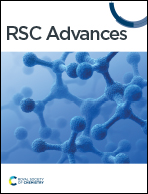Antimony and naphthalene can be simultaneously leached from a combined contaminated soil using carboxymethyl-β-cyclodextrin as a biodegradable eluant
Abstract
In this study, we have investigated the removal efficiency of antimony (Sb) and naphthalene (Nap) from a combined contaminated soil by carboxymethyl-β-cyclodextrin (CMCD) leaching and reveal its remediation mechanisms by FTIR and 1H NMR analyses. The results show that the highest removal efficiencies of Sb and Nap were 94.82% and 93.59%, respectively, with a CMCD concentration of 15 g L−1 at a pH of 4 and a leaching rate of 2.00 mL min−1 over an interval-time of 12 h. The breakthrough curves show that CMCD had a stronger inclusion capacity of Nap than Sb, and Sb could enhance the adsorption capacity of Nap, while Nap weakened the adsorption of Sb during CMCD leaching. Furthermore, the FTIR analysis suggests that the removal of Sb from combined contaminated soil involved complexation with the carboxyl and hydroxyl groups on CMCD, and the NMR analysis suggests that the inclusion of Nap occurred. These results indicate that CMCD is a good eluant for remediating soil contaminated by a combination of heavy metals and polycyclic aromatic hydrocarbons (PAHs), and its remediation mechanisms depend on the complexation reactions between the surface functional groups and inclusion reactions in the internal cavities.



 Please wait while we load your content...
Please wait while we load your content...